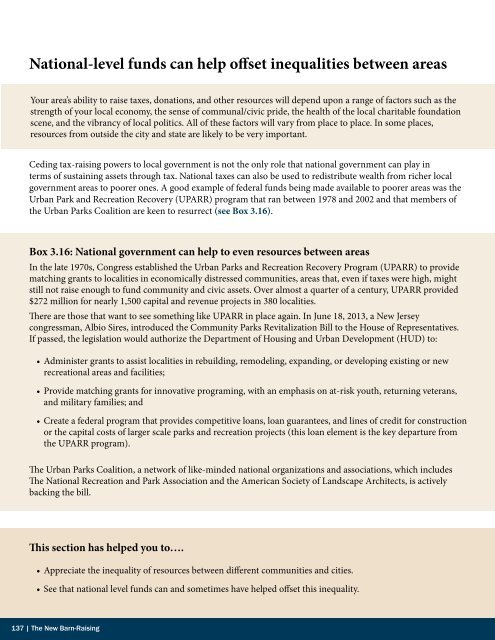bQNs7mR
bQNs7mR
bQNs7mR
You also want an ePaper? Increase the reach of your titles
YUMPU automatically turns print PDFs into web optimized ePapers that Google loves.
National-level funds can help offset inequalities between areas<br />
Your area’s ability to raise taxes, donations, and other resources will depend upon a range of factors such as the<br />
strength of your local economy, the sense of communal/civic pride, the health of the local charitable foundation<br />
scene, and the vibrancy of local politics. All of these factors will vary from place to place. In some places,<br />
resources from outside the city and state are likely to be very important.<br />
Ceding tax-raising powers to local government is not the only role that national government can play in<br />
terms of sustaining assets through tax. National taxes can also be used to redistribute wealth from richer local<br />
government areas to poorer ones. A good example of federal funds being made available to poorer areas was the<br />
Urban Park and Recreation Recovery (UPARR) program that ran between 1978 and 2002 and that members of<br />
the Urban Parks Coalition are keen to resurrect (see Box 3.16).<br />
Box 3.16: National government can help to even resources between areas<br />
In the late 1970s, Congress established the Urban Parks and Recreation Recovery Program (UPARR) to provide<br />
matching grants to localities in economically distressed communities, areas that, even if taxes were high, might<br />
still not raise enough to fund community and civic assets. Over almost a quarter of a century, UPARR provided<br />
$272 million for nearly 1,500 capital and revenue projects in 380 localities.<br />
There are those that want to see something like UPARR in place again. In June 18, 2013, a New Jersey<br />
congressman, Albio Sires, introduced the Community Parks Revitalization Bill to the House of Representatives.<br />
If passed, the legislation would authorize the Department of Housing and Urban Development (HUD) to:<br />
• Administer grants to assist localities in rebuilding, remodeling, expanding, or developing existing or new<br />
recreational areas and facilities;<br />
• Provide matching grants for innovative programing, with an emphasis on at-risk youth, returning veterans,<br />
and military families; and<br />
• Create a federal program that provides competitive loans, loan guarantees, and lines of credit for construction<br />
or the capital costs of larger scale parks and recreation projects (this loan element is the key departure from<br />
the UPARR program).<br />
The Urban Parks Coalition, a network of like-minded national organizations and associations, which includes<br />
The National Recreation and Park Association and the American Society of Landscape Architects, is actively<br />
backing the bill.<br />
This section has helped you to….<br />
• Appreciate the inequality of resources between different communities and cities.<br />
• See that national level funds can and sometimes have helped offset this inequality.<br />
137 | The New Barn-Raising


